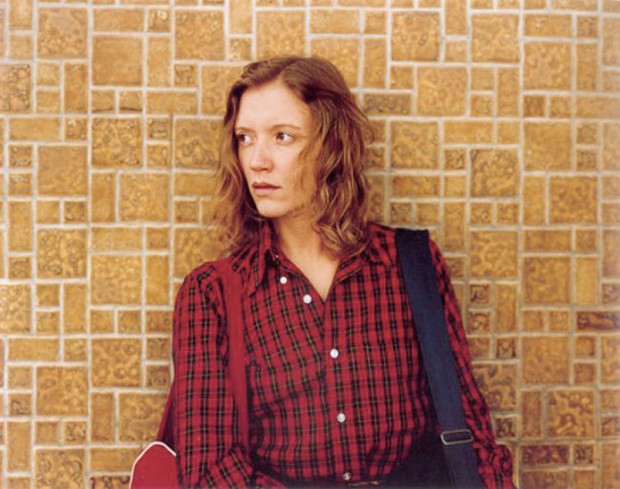An iconographic and text archive related to communication, technology and art.
☛ Phaidon: “Ginger Shore, Causeway Inn, Tampa, Fla., Nov. 17, 1977” by Stephen Shore, colour photograph, 51 x 61cm. This photo is part of the Uncommon Places series © Stephen Shore.
The woman in the picture is Ginger Shore, Stephen Shore’s wife. Here’s how Michael Kimmelman from The New York Times commented the photo in a piece he wrote back in 2007. He was then reviewing an exhibition held at the International Center of Photography (in New York) titled “Biographical Landscape: The Photography of Stephen Shore, 1969–79”:
There are a few pictures that look genuinely inchoate, their formal logic obscure. But in Tampa Mr. Shore photographed a young woman (his future wife, Ginger) standing, her back to the camera, soaking wet, in the pool of the Causeway Inn, the far edge of the pool making a diagonal line parallel to the shiny handrail in the foreground, locking the composition down. Sunlight creates a chicken wire of reflections in the turquoise water.
Why that moment at that spot and not another? Mr. Shore’s pictures, like his diary entries, imply the arbitrary ways we make sense of life, choosing to note certain things but not others, framing the world so that what we see comes into focus, thereby excluding what doesn’t fit. (The New York Times: “Passing Mile Markers, Snapping Pictures”, May 18, 2007)
Below is another photograph of Ginger taken by Stephen Shore about a month later, on December 1977 (the image was retrieved from Art Tattler).

Shore commented this photo in an interview he gave to Aaron Shuman in 2004: “Uncommon Places: An Interview with Stephen Shore” (SeeSaw Magazine, January 2004):
AS: When did you meet your wife?
SS: ’76.
AS: And did she start traveling with you when you shot? Did she come along?
SS: Occasionally. When it fit in with her job.
AS: Did that change the way you worked at all?
SS: No. I’m a maniac when I shoot. I mean, I’m focused like a laser beam, and I’m not the “loving boyfriend”. I’m the “artist”, and she understood this—that if you’re on a trip with me, the purpose of this trip was for me to make pictures, and I’m not going to be a nice guy or anything. I’m taking pictures. And if you’re around, you’re there to help me. See here, in this picture [pointing at portrait. Ginger Shore, 1977] she’s carrying my equipment. I used to use an old TWA bag for my film holders, these are my film holders [red strap over Ginger’s right shoulder], and this is my camera bag wit extra lenses [blue strap over Ginger’s left shoulder]. I mean, it takes a lot of understanding on her part, to do that; to participate in a trip like that. So, in fact, it doesn’t affect my shooting. Except that it expanded my subject matter, because I could photograph her.
AS: Yeah, I noticed that, in this book, as that relationship developed there were more and more pictures of her. Did you marry in ’77?
SS: No, we married later. I realize that the titles are “Ginger Shore”, but I just felt that I couldn’t use her previous name on the picture. [Laughs.]
AS: Because the essay for the new book describes these pictures as being seen, in some ways, as that classic, American, “young man alone in the world, trying to find himself, and his place”, and so on; that kind of Kerouac, “On the Road” cliché. And the reason I ask about your wife is that; it seems that once you found someone—I’m wondering if that’s when you felt like the project was winding down, or that you were settling down. Basically, I’m wondering what brought you to an end.
SS: That’s a very good question. I think there were a number of things. I think there was a settling down. I mean my life changed. I was no longer a boy alone; I now had someone I wanted to live with. And I think something else happened at the same time, which is, I mentioned that I started in this process of formal questions being raised. That as I was working, there would be this issue that I felt I had to deal with—to solve, visually. And in the process of answering this question, other questions would arise. And this process went on, almost of its own accord. I mean, I didn’t just sit around thinking, “What problem am I going to deal with next?” It would just bubble up. And that went on from ‘73, when I started using the 4×5, ‘til about the end here [points at Bozeman, Montana, 1981]. And then it just stopped. And no more questions arose. And it seemed like that was the end of the project. I could actually use this to get back to the Sally Eauclaire question. See, at first, that situation confused me, and I didn’t know what that meant. I didn’t know why this would stop happening. And, did it mean that I lost it. And it took me a long time, I mean years I would say, to understand and have perspective on it, and to realize that what had happened was—it feels stupid to say, but my “innate modesty” prevented me from even recognizing it—that I didn’t have any more questions of that kind. That I’d answered them, and now it was time for a different phase in my work.
For more about Stephen Shore, visit 303 Gallery.
• • •
See previously here: Stephen Shore on framing in Japanese woodblock prints.
- By Philippe Theophanidis
- on
- ― Published in Art, Photography
- Tagged: frame, heat, pool, space, Stephen Shore, water, woman

